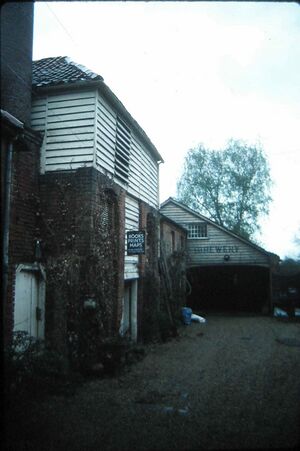Gardner & Son
E Gardner & Son, Little Coggeshall Brewery, Bridge Street, Coggeshall, Essex.
Founded in 18th century by Henry Skingley and sold to Gardner.
Leased to Greene King & Sons Ltd January 1941 with 7 public houses and closed in 1943. The adjacent pub, the Porto Bello, was formerly the Bell and dates from c.1750.
Both brewery and pub are still standing as private residences.
From ESSEX BREWERS - The Malting and Hop Industries of the County by Ian P Peaty 1992 now out of print ISBN 978 1 873966 02 4
On the Tithe map of 1827 land stretching from the bridge to the small stream is shown as in the ownership of Gardner, on which there is also indicated a public house called The King's Arms. The present Porto Bello Inn was built in 1853 as the tap house to the brewery built behind it, with a yard separating the brewery from the owners house, "Bridge House", all extant today. Gardners also built a malthouse on the same land alongside the River Blackwater. The first entry in Directories is in 1839 as both a brewer and maltster, but with a malthouse located in West Street.
William Gardner traded under his own name up until 1877, when upon his death his widow, Mrs Elizabeth Gardner carried on brewing with her son's name as part of the title. Elizabeth was born in Stepney, East London in 1822, and her son, Frederick, was born in 1856 and was described in the 1887 census as a brewers clerk. The trade name of Mrs Elizabeth Gardner and Son was in use up until 1902, with the following thirty-six years the business was known as E.Gardner and Son. They leased to Greene King & Sons Ltd. Bury St Edmunds on 9th January, 1941, included in the lease were eleven public houses.
The brewery was kept in a "moth-ball" situation during the war in case of a need for an alternative location to brew.
Gardners were awarded a Diploma of Honour for Pale Ale/Bitter Beer at the National Brewers Exhibition in 1888, further gold medals were awarded in 1890.
Brewing ceased in 1943 but the premises are still standing, without equipment, but complete with licensing names denoting the various working areas. The only remaining item is a Yorkshire Square. Bridge House remains a fine residential property to the right of the yard entrance. The riverside maltings were converted into multiple residential use in the late 1980's.
An assortment of images of the brewery









